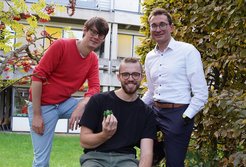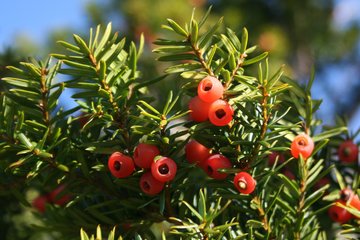“We can try to guide evolution into another direction”
In our interview, Luca Schulz, Georg Hochberg and Tobias Erb explain why knowing the history of proteins might help create alternatives for the future

What was the starting point for your research?
Tobias Erb: Studying the mechanisms that allow enzymes to capture and convert CO2 is at the heart of research in our lab. But how did these powerful CO2-converting catalysts emerge and adapt to dramatic changes in the environment over billions of years? In paleontology we can make use of fossilized bones to understand the evolution of species, like us humans. However, there is no “molecular fossils” of proteins that we could use to learn about their evolution. Meeting Georg [Hochberg], who is an expert in reconstructing the history of proteins over billions of years opened the exciting possibility to finally go back in time to reconstruct ancient Rubisco versions. Through this molecular time travel, we can now retrace the key steps in the history of Rubisco.
The proteins you are studying have long since disappeared on earth. Why is this relevant for us humans today?
Luca Schulz: We were only able to measure the impact that a new protein component had on Rubisco, because we looked at it in ancestral proteins. In extant proteins, such an analysis is near impossible, because Rubisco does not function properly anymore as soon as you remove the novel component. Over the course of evolution, Rubisco started to depend on its novel component. As such, studying long-gone proteins can help us circumvent confounding factors that complicate the analysis of individual aspects of a protein.
Tobias Erb: Well, every bite of food that you take, every carbon atom that you eat is basically CO2 that was fixed through Rubisco. This enzyme literally feeds all life on this planet. I believe that there is some value in understanding how this essential process on earth evolved. One lesson is that evolution apparently tends to build more complex machines with time. Understanding the molecular principles behind this process tells us about the potential, but also the limitations of evolution as an optimization force.
There is another angle to the story: we can try to use this knowledge to replay evolution and guide it into another direction.
How could we theoretically use this knowledge to boost photosynthesis?
Georg Hochberg: Evolution is a tinkerer. It uses what parts it has available to improve what’s already there, rather than building its solutions from the ground up like an engineer would. That means that its solutions aren’t always optimal. But we can still learn from this erratic process. In this particular case, we learned a new principle for how the properties of Rubisco can be changed: through addition of an evolutionary modulator like its new subunit. I would wager that there are other modulators that we could add to this protein that might change Rubisco’s properties even more drastically than the one it acquired historically.
Tobias Erb: So far, scientists mainly focused on modifying Rubisco itself by changing the enzyme’s core to improve its catalysis. However, this has only met with limited success. The surprising discovery of our study is that you can improve Rubisco by simply adding additional protein components that ‘activate’ otherwise silent mutations in the protein.
This gives a completely different perspective on future engineering efforts. Imagine that we do not have to modify the core of the enzyme itself, but screen for new modulators that allow us to unleash the full catalytic power that is already present, but hidden in the enzyme’s core. This is a completely novel road that no one has taken so far.
Why is this research important in the context of climate change?
Tobias Erb: Our research has two important aspects. We can try to make predictions about future scenarios and answer the question whether we can overcome the current limitations of Rubisco. Remember, that the enzyme is (still) surprisingly slow and can tolerate, but not fully discriminate against oxygen. And this brings me also to the second aspect of our research, which is more applied. We can now think about replaying the tape of evolution with our ancestral proteins provide it with completely novel interaction partners to improve the enzyme’s catalysis and eventually overcome the natural limitations.












